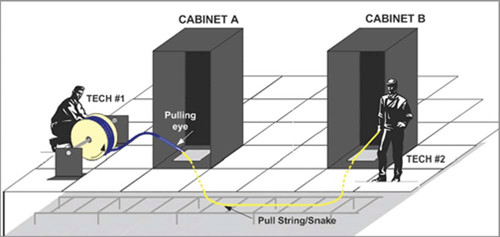When deploying a fiber network, people nowadays not only appreciate the high-speed broadband services, but the maintenance of how long it will last. After all, optical fiber is a particular type of hair-thin glass with a typical tensile strength that is less than half that of copper. Even though the fiber looks fragile and brittle, but if correctly processed, tested and used, it has proven to be immensely durable. With this in mind, there are essentially factors that will affect the longevity of your fiber network.

Installation Strains
Stress, on the other hand, is a major enemy of fiber longevity, so the protection task is passed to the cable installer, who will ensure that the use of suitable strength elements limits the stress applied to the cable to much less than the 1 per cent proof test level. The installer then needs to ensure that the deployment process does not overstrain the cable. Figure 2 below illustrates a typical crew deployment for a trunk installation. The whole process should be paid more attention to the stress.

Of the three techniques commonly used—pulling, pushing and blowing, only pulling creates undesirable stretching (tensile stress). Unlike metal, glass does not suffer fatigue by being compressed, and so the mild compression caused during pushing causes no harm to the fiber.
Surface Flaws
Optical fiber typically consists of a silica-based core and cladding surrounded by one or two layers of polymeric material (see in Figure 3). Pristine silica glass that is free of defects is immensely resistant to degradation. However, all commercially produced optical fibers have surface flaws (small micro-cracks) that reduce the material’s longevity under certain conditions. The distribution of flaws on the surface of the silica-based portion of the fiber largely controls the mechanical strength of the fiber. FS.COM fiber optic cables are well tested to ensure less surface flaws, like LC to ST fiber cable.

To conquer this, reputable fiber suppliers carry out proof testing, which stretches the fiber to a pre-set level (normally 1 per cent) for a specified duration to deliberately break the larger flaws. And the user is then left with a fiber containing fewer, smaller flaws that need to be protected from unnecessary degradation. This means primarily stopping the creation of new flaws by coating the fiber with a protective and durable material for its primary coating.
Environmental Factors
Once deployed, the local environment has a big impact on fiber life. Elevated temperatures can accelerate crack growth, but it is the presence of water that has been historically of most concern. The growth of cracks under stress is facilitated by water leading to "stress corrosion". You can check what the tendency of a fiber to suffer stress corrosion is by reviewing its "stress corrosion susceptibility parameter", much more conveniently referred to as "n". A high n value (around 20) suggests a durable fiber and coating.
Calculating How Long Your Network Will Last
Bearing in mind the three factors above, how can you calculate the lifetime of your fiber network? In general, the chances of a fiber being damaged by manual intervention, such as digging, over the same time frame is about 1 in 1,000. Quality fiber, installed by benign techniques and by careful installers in acceptable conditions should, therefore, be extremely reliable - provided it is not disturbed.
It is also worth pointing out that cable lengths themselves have rarely failed intrinsically, but there have been failures at joints where the cable and joint type are not well matched, allowing the fibers to move - for example, due to temperature changes. This leads to over stress of the fiber and eventual fracture.
Conclusion
To tell the truth, the biggest enemies to the carefully engineered reliability of fiber jumper can be either humans or animals, rather than the fused silica itself. The provided fibers are stored and coiled correctly, it is quite possible that they turn out to be stronger than we at first thought and perhaps the original flaws begin to heal with time and exposure to water under low stress levels. FS.COM offers high quality fiber cable assemblies such as Patch Cords, Pigtails, MCPs, Breakout Cables etc. All of products are well tested before shipment.
评论
发表评论